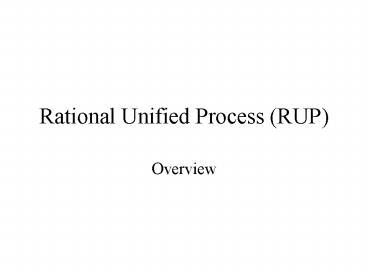Rational Unified Process RUP - PowerPoint PPT Presentation
1 / 13
Title:
Rational Unified Process RUP
Description:
P. Krutchen answers this from several perspectives in his Rational Edge article ... P. Krutchen, Architectural Blueprints - The '4 1' View Model of Software ... – PowerPoint PPT presentation
Number of Views:2045
Avg rating:5.0/5.0
Title: Rational Unified Process RUP
1
Rational Unified Process (RUP)
- Overview
2
Outline
- What is the Rational Unified Process?
- Overview
- Tailoring the Rational Unified Process
- 41 view of the architecture
- References
3
What is the Rational Unified Process?
- P. Krutchen answers this from several
perspectives in his Rational Edge article - What is the purpose of the RUP?
- a software engineering process
- guides software development organizations in
their endeavors - How is the RUP designed and delivered?
- process product
- integrated with the Rational suites of software
development tools - What is the structure of the RUP how is it
organized internally? - has a very well-defined and regular structure
(phases, workflows) - uses an object-oriented approach for its
description - How would an organization proceed to adopt the
RUP? - tailor or extend the RUP to match its specific
needs - What will I find in the RUP?
- captures best practices harvested by Rational
over the years
4
What is the Rational Unified Process?
- Purpose of RUP
- Organizations have become aware of how important
a well-defined and well-documented software
development process is to the success of their
software projects - The development of the CMM (Capability Maturity
Model) by the Software Engineering Institute
(SEI) has become a standard to which many
organizations look - Some organizations have collected their knowledge
- design methods, textbooks, training programs,
how-to notes - unfortunately, in practice, these internally
developed processes rapidly become obsolete, and
almost never followed - Other organizations have little or no process at
all - need a starting point
- The RUP can help both kinds of organizations, by
providing them with a mature, rigorous, and
flexible software engineering process.
5
What is the Rational Unified Process?
- RUP Is a Process Product
- designed and documented using the Unified
Modeling Language (UML) - delivered online using Web technology
- easy to access
- regular upgrades are released
- process is never obsolete
- users benefit from the latest development
- All team members access the same version of the
process - modular and in electronic form
- can be tailored and configured to suit the
specific needs of a development organization - integrated with the many software development
tools in the Rational Suites - developers can access process guidance within the
tool they are using
6
What is the Rational Unified Process?
- RUPs Architecture
- underlying object-oriented model, using UML
- overall architecture has two structures or, if
you prefer, two dimensions - The horizontal dimension represents time and
shows the lifecycle aspects of the process as it
unfolds - The vertical dimension represents core process
disciplines (or workflows), which logically group
software engineering activities by their nature
7
What is the Rational Unified Process?
(this Figure is from P. Krutchens paper)
8
What is the Rational Unified Process?
- the horizontal dimension represents the dynamic
aspect of the process - cycles, phases, iterations, and milestones
- a software product is designed and built in a
succession of incremental iterations - Early testing and validation of design ideas
- Early risk mitigation
- The vertical dimension represents the static
aspect of the process described in terms of
process components activities, disciplines,
artifacts, and roles
9
What is the Rational Unified Process?
Over time
(this Figure is from www.rational.com)
10
What is the Rational Unified Process?
- Adopting the RUP
- process framework can be adapted and extended to
suit the needs of an organization - can also modify, adjust, and expand the Rational
Unified Process to accommodate the specific
needs, characteristics, constraints, and history
of its organization, culture, and domain. - The process elements that are likely to be
modified, customized, added, or suppressed
include artifacts, activities, workers, and
workflows as well as guidelines and artifact
templates - Starting in 2000, the RUP contains several
variants, or pre-packaged development cases for
different types of software development
organizations.
11
What is the Rational Unified Process?
- RUP Captures Current Best Practices
- Develop software iteratively
- Manage requirements
- Use component-based architectures
- Visually model software
- Continuously verify software quality
- Control changes to software
12
What is the Rational Unified Process?
- RUP Software Architecture
- Architecture activities the 41 view
- logical view
- object model of the design (when an
object-oriented design method is used) - process view
- captures the concurrency and synchronization
aspects of the design - physical view
- describes the mapping(s) of the software onto the
hardware and reflects its distributed aspect - development view
- describes the static organization of the software
in its development environment - use case view
13
References
- P. Krutchen, The Rational Unified Process An
Introduction (2nd Edition), Addison-Wesley Pub.
Co 1st edition (April 8, 2003) - P. Kroll, P. Krutchen, G. Booch, The Rational
Unified Process Made Easy A Practitioner's Guide
to Rational Unified Process, Addison-Wesley Pub.
Co 2nd edition (March 14, 2000) - P. Krutchen, What is the Rational Unified
Process, The Rational Edge e-magazine, January
2001 - P. Krutchen, Architectural Blueprints - The "41"
View Model of Software Architecture,
www.rational.com - SE 6354 course page under resource section
- Rational's website (search for whitepapers)
- Rational Unified Process - overview (sample
chapter of Krutchens new book) - Tailoring RUP for a Team of One (interesting
article on scaling down RUP)






























